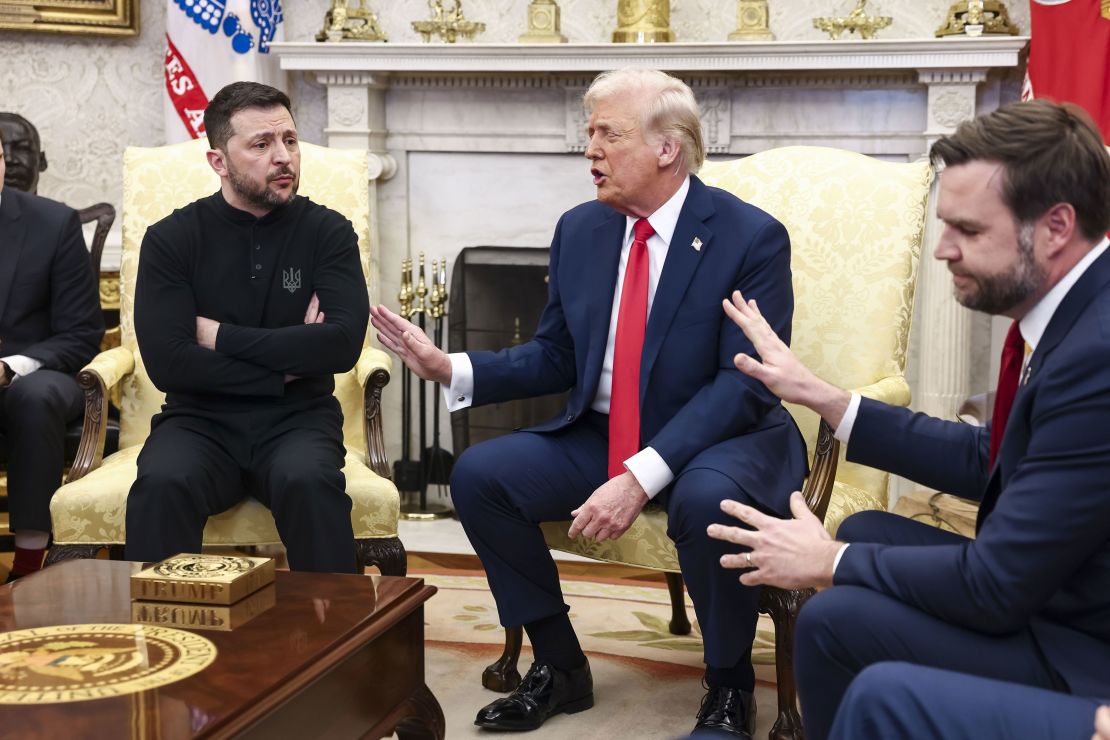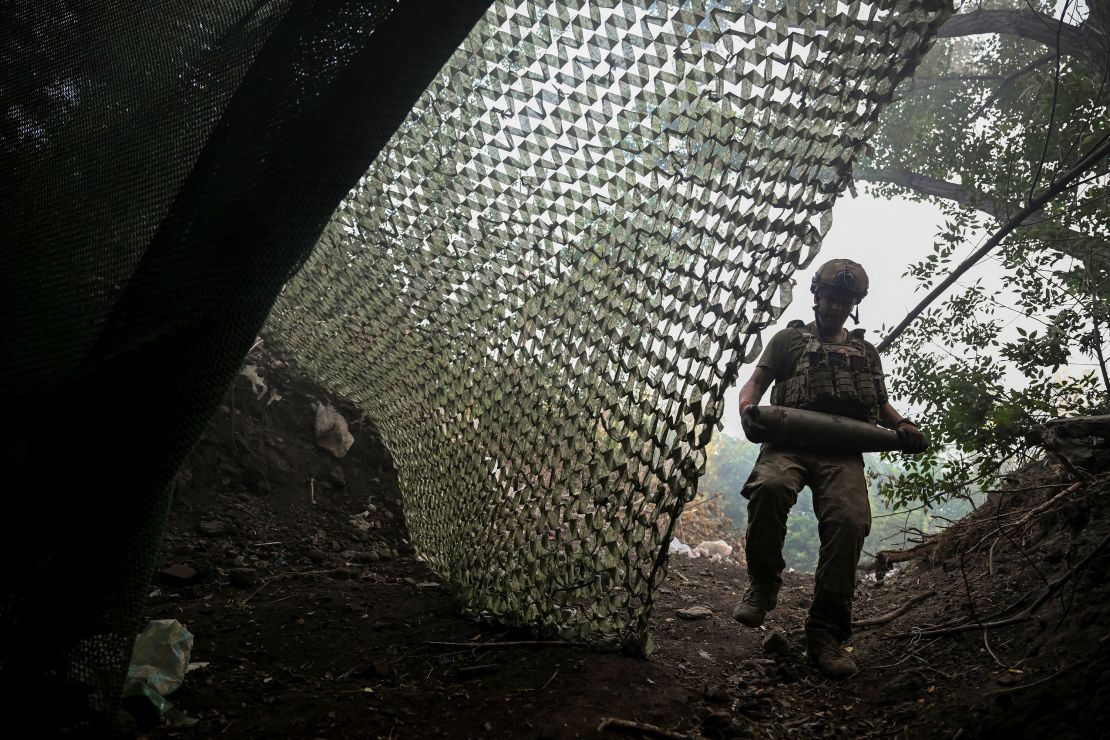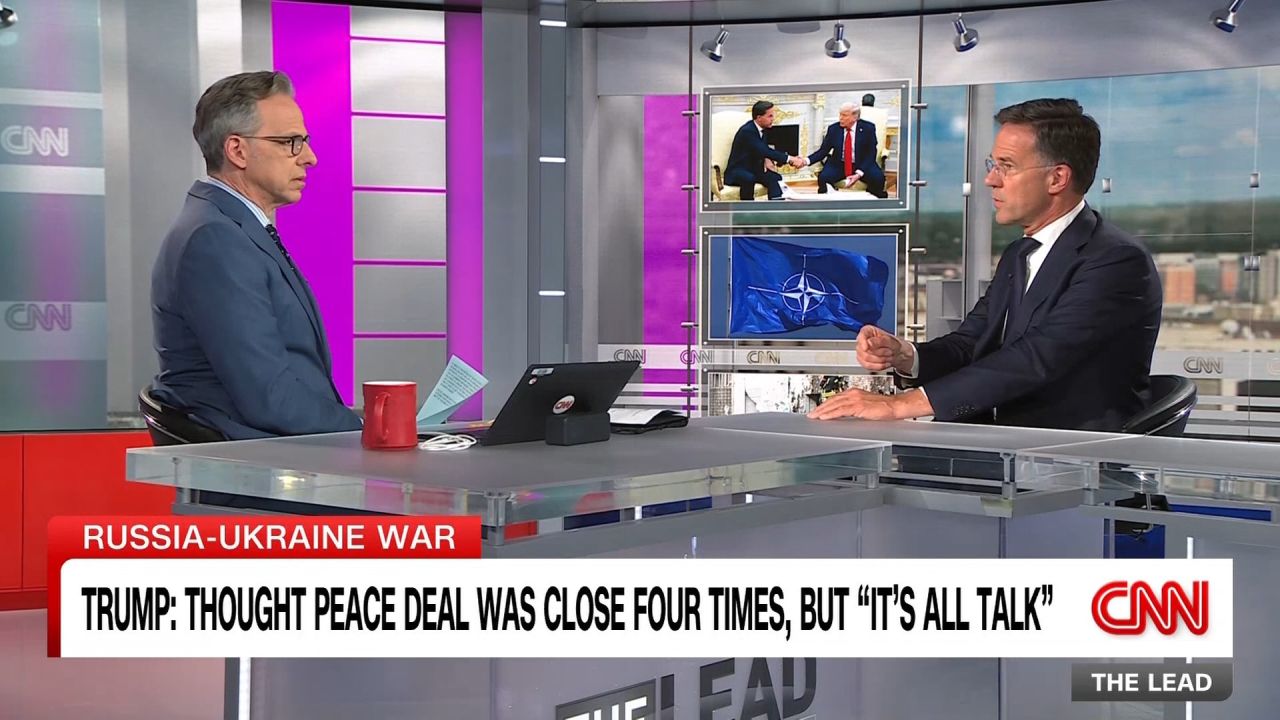Brett McGurk is a CNN global affairs analyst who served in senior national security positions under Presidents George W. Bush, Barack Obama, Donald Trump and Joe Biden.
CNN
—
To appreciate the dramatic shift in President Donald Trump’s policy towards Ukraine, consider two scenes in the Oval Office, months apart:
On February 28, Trump berated Ukrainian President Volodymyr Zelensky in front of the global news media, declaring that he has “no cards” and effectively no choice but to sue for peace with Russia and largely on Russia’s terms. Shortly after that meeting, the United States announced a temporary pause on all military and intelligence support for Ukraine.
On July 14, Trump met with the secretary general of NATO, Mark Rutte, and announced significant new cards for Zelensky, in the form of billions of dollars in military equipment, including advanced anti-air systems, and new sanctions on Russia to go into effect 50 days from now if Russian President Vladimir Putin continues to prosecute the war.
These scenes bookmark a chapter of ineffective American diplomacy and the beginning of a new and more promising one: diplomacy backed by the leverage ultimately required to stop a war that Putin has otherwise demonstrated he intends to continue indefinitely.
Dancing with a bear
Theodore Roosevelt once said, “Diplomacy is utterly useless, where there is no force behind it.” This is particularly true when it comes to diplomacy with Russia, a task I’ve confronted with some difficulty as an envoy for Presidents Obama and Trump.
As a presidential envoy leading the campaign against the Islamic State in Iraq and Syria (ISIS), one of my jobs was to lead a diplomatic channel with Russia over its support of the Assad regime in Syria. The aim was primarily to keep Russian forces away from ours as we prosecuted the campaign against ISIS. The Russians wanted Syria to themselves, and they often sought to limit our maneuvering space.
My main Russian counterpart was a seasoned diplomat and confidant of Putin’s named Alexander Lavrentiev. He and his team of military officials and diplomats often said all the right things at the table, promising ceasefires and drawing lines on maps where Russian forces would operate separate from ours to avoid any risk of a direct clash. Often, however, the actions of Russian forces on the ground sent precisely the opposite message, conducting airstrikes near Syrian forces backed by the United States, or maneuvering provocatively to test whether US military forces were truly prepared to defend the lines we had drawn on a map through our diplomatic channel.
This came to a head in early 2018 as the United States was consolidating positions around Raqqa, a city recently seized from ISIS and from where ISIS had actively planned terrorist attacks into Europe and the United States. The Euphrates River snakes just south of the city and presents a natural dividing line between northeast and southeast Syria, a line we told the Russians not to cross.
The Russians kept proposing that we back off from Raqqa and claimed they should rehabilitate the city with forces backed by the Assad regime, ideas we repeatedly and consistently rejected at the negotiating table.
In February 2018, Russian-backed mercenary forces known as the Wagner Group crossed the Euphrates River together with Syrian forces in a misguided effort to test our resolve. As the column of armored vehicles approached a US position and kept advancing despite repeated warnings to stop, US military forces acted in self-defense and annihilated the column.
The next time I met with Lavrentiev, he never mentioned the incident, but he and his team suddenly accepted our boundaries without question, and we never had another problem or incident as we continued the ISIS campaign to a successful conclusion.
A Russian expert on my team said the Russians approach diplomacy as a bear approaches a dance. The bear knows it will determine when and how the dance ends, unless the other dance partner proves itself to be a bigger bear. Sometimes, it helps to be the bigger bear.
In the context of Ukraine, like Syria, while the United States is a far more powerful country than Russia, Putin believes that he has the upper hand in such localized conflicts due to Moscow’s determination and consistency contrasted with Washington’s perceived lack of focus, stamina and shifting politics through election cycles.
Correcting that perception is a first principle for effective diplomacy with Moscow, and the approach outlined by Trump yesterday offers the chance to do exactly that.
Diplomatic inertia
So, how did we get here?
As a candidate, Trump pledged to end the war in Ukraine on “Day One” of his presidency. Many of his top advisors had long suggested that Russia’s invasion of Ukraine was somehow provoked by the United States, or by Ukraine’s expressed desires to be integrated with Europe and not a satellite of Moscow.
This misreading of the conflict’s origins – in fact, Putin launched an unprovoked invasion in 2022 with an aim to conquer all of Ukraine, a goal he has failed to achieve due entirely to Ukraine’s defense of its territory backed by a pipeline of western military supplies – led to a diplomatic strategy that appealed to Putin’s good will and incentives such as proposals for trade and sanctions relief while at the same time pulling back support from Ukraine. For example, Trump formally took NATO membership for Ukraine off the table, while also suggesting that Washington’s support for Ukraine’s defense would soon run dry.
The result has been a Ukraine that accepted multiple ceasefires backed by Washington, only to see Russia – sensing vulnerability in Kyiv – escalate the war in response.
As I discussed on CNN this past Friday, it was five months ago that Ukraine formally accepted an unconditional ceasefire proposed by the Trump administration. In response, Secretary of State Marco Rubio and then-National Security Adviser Mike Waltz declared in a joint statement with Ukraine that Washington would communicate to Putin that “Russian reciprocity is the key to achieving peace.”
Since then, Trump has held three phone calls with Putin and his envoys have made multiple trips to Moscow or have met with Putin and Russian diplomats elsewhere.
To say there has been no “Russian reciprocity” in response to these ceasefire proposals would be an understatement. Russia in recent months and often within 24 hours of Putin’s calls with Trump, has launched the largest air raids of the war: thousands of missiles and drones striking cities randomly and with no apparent strategic aim but to sow terror among the civilian population.
Ukraine, as it has done since the moment of invasion, responded defiantly and with new tactics of its own, striking with drones deep into Russian territory and against clear military targets – unlike Moscow’s tactics – such as air bases, and destroying the bomber aircraft that Russia has been using to target Ukrainian cities.
Inflection point
So, after months of diplomacy and a war that seems further from a ceasefire than ever, the Trump administration confronted an inflection point with two options.
One option was to declare indifference and abandon diplomacy while allowing Ukraine’s defensive military systems to deplete, thereby shifting military advantage decisively towards Moscow. Vice President JD Vance previewed such an approach on April 23, saying, “We’ve issued very explicit proposals to both the Russians and the Ukrainians, and it’s time for them to either say yes or for the United States to walk away from this process.”

The other option was to reinforce diplomacy with a demonstration of commitment to Ukraine through military resupplies, coordination with allies and imposing additional costs on Putin should he choose to continue the war. Under this option, the US would stick to the objective of a ceasefire – this war can only end with a deal – but the tactics for getting there would shift away from pleading appeals to Putin’s good will and recognition that Russia (not Ukraine) has been the obstacle to peace.
Trump has apparently chosen the second option, and rightly so.
The former “walk away” option would have led only in one direction: Russian escalations against Ukrainian cities and new ground offensives with Ukraine increasingly unable to defend itself or its people, leading to thousands of civilian deaths and Moscow believing it might ultimately achieve its original goal: the subjugation of Ukraine in its entirety.
The second option, if carried through, will save lives in Ukraine while demonstrating to Russia that continuing its war of choice will be futile and increasingly costly, thereby making a ceasefire and diplomatic settlement more likely over time.
Notably, Trump appears to have chosen this new course against the advice of some advisers, including his senior civilian team at the Pentagon, which only last week had ordered a pause on all military deliveries to Ukraine. Trump, in responding to questions by CNN’s Kaitlan Collins, claimed to have not known about this decision, or who made it – and then abruptly reversed it. This suggests that Trump himself is bought into the new direction on Ukraine, which may well give the policy more staying power.
Trump perhaps best summed up the logic behind the shift in a comment about Putin to reporters before returning to Washington on Sunday night: “He talks nice and then he bombs everybody in the evening.” Putin, in other words, misplayed his own cards.
New approach: leveraged diplomacy
While this new approach is continuing to evolve, the broad outlines are in view with three main components.
-
Military Support for Ukraine: In the meeting yesterday with Rutte, Trump announced a new US policy to sell military systems directly to NATO allies, with the understanding that allies would then transfer the systems directly to Ukraine. This is important because until now, Trump had refused to replenish the pipeline of supplies to Ukraine established by the Biden administration once it ran dry. Selling systems to allies allows Trump to claim that he’s doing something different from Biden, while also continuing to replenish badly needed supplies and military systems for Ukrainian forces.
-
Coordination with Allies: Preceding this announced shift in policy, the president had just participated in a successful NATO Summit where allies committed to a target of defense investment at 5 percent of national GDP. This is a significant increase above the current 2-percent target for NATO allies, and above even what the United States spends on defense as a percentage of GDP (just above 3 percent). In a unanimous statement after the summit, NATO allies also declared Russia “a long-term threat to Euro-Atlantic security,” held Russia entirely responsible for the war, and called on Russian forces to withdraw. This unanimity was surely a surprise to Putin, who tends to count on European divisions and America’s lack of conviction on Ukraine. The NATO summit was bookended by the US military strike into Iran and then a conference in Rome with European partners and the US pledging significant economic support for Ukraine as it looks to withstand and then recover from the war. This display of American power and newfound consensus with allies will be noted in Moscow.
-
Threat of New Sanctions: In an era of intensive political discord in Washington, Ukraine carries a unique consensus as shown by a Russia sanctions bill now pending before the Senate with more than 82 co-sponsors. Initially backed by Republican Sen. Lindsey Graham of South Carolina, and Democratic Sen. Richard Blumenthal of Connecticut, the bill has been awaiting a green light from the White House. That appears to have now happened, with both Senate Majority Leader John Thune and Speaker of the House Mike Johnson previewing possible votes before August recesses, as CNN has reported. This bill would impose massive US tariffs on countries that purchase Russian oil and gas, namely India and China. Yesterday, Trump confirmed that 100-percent tariffs will be imposed on these countries in 50 days if Russia continues to prosecute the war. Used wisely, this threat combined with the bipartisan legislation can be brandished to encourage Beijing, New Delhi, and others to press Moscow into accepting a US-backed ceasefire within this timeframe.
Can it work? Yes
This new approach has potential to significantly buttress American diplomacy over the coming months given Russia’s already staggering losses in Ukraine. By even conservative estimates, Russia has suffered over 1 million military casualties, including over 250,000 dead. It’s lost more than 10,000 tanks and armored vehicles, and its vaunted Black Sea naval fleet is now mostly at the bottom of the Black Sea.

Direct military costs are estimated to be above $300 billion and growing together with frozen assets and GDP losses for Russia in the hundreds of billions of dollars. The churning of manpower is reportedly causing record shortages of factory workers and essential labor needed to sustain Russia’s war effort.
Putin had clearly hoped that Trump’s shift away from Ukraine might allow for these trends to reverse and set his campaign on a more sustainable trajectory as the Ukrainians ran out of resources to sustain their own defense. So long as this new US policy continues, however, Putin will have few options to meaningfully reverse these trends, and he will need to recalculate the costs of continuing a war that is bleeding resources for little gain.
It is important now for the White House to drive this policy forward and for Trump to stick to his new convictions, which combined with bipartisan majorities in Congress and the strong backing of allies carries the best chance to force this recalculation in the Kremlin.
Conclusion
Trump yesterday announced a dramatic shift in Ukraine policy, opening a new chapter for American diplomacy and ongoing efforts to stop Russia’s war. It was the right move, and one that deserves bipartisan backing and follow through from partners and allies. The most important thing for Putin to understand is that the United States is not going to waver, and that the consequences for Moscow will only worsen the longer the war continues.
Because even in Ukraine, when standing with allies, the US is the biggest bear around.



